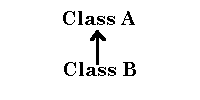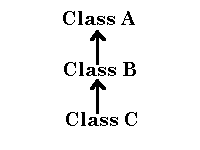
| Home : Course Map : Chapter 4 : Java : |
|
Class Inheritance
|
| JavaTech |
| Course Map |
| Chapter 4 |
|
Introduction
|
| Supplements
Override/Overload Annotation-J2SE5.0 Java Security Class Loading Class Verifier SecurityManager |
| About
JavaTech Codes List Exercises Feedback References Resources Tips Topic Index Course Guide What's New |
|
A key feature of object oriented programming concerns the ability of a class to inherit an existing class and increase its capabilities. Here, for example, class B inherits, or extends, class A :
In the diagram at the left, by convention, the superclass is on top and subclasses are below and point upwards to the base class. The class B above then has capabilities equivalent to class B1 shown below:
An instance of either class B or B1 both possess i and j variables and the two methods. The class definition of class B is much smaller than B1 because the compiler will link the members of the A base class to class B. Inheritance allows subclasses to build on a superclass to add new capabilities while the superclass is still available for situations where the new capabilities are not needed or applicable. Inheritance does more than reduce the size of the subclass definitions. We will see that the inheritance mechanism offers several new capabilities including the ability to re-define, or override, a method in the superclass with a new one. We can now create instances of class B and access methods and data in both class B and class A (since they are public - access modifiers will be discussed later.)
Another class can in turn inherit class B:
Now an instance of class C can use the class C data and methods and also those of both classes B and C.
Latest update: Oct.24, 2004 |
|
Tech |
|
Physics |


